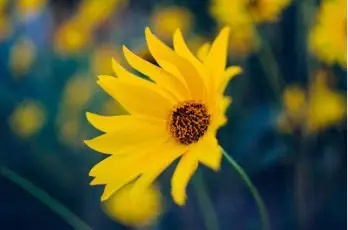There are over 70 varieties of sunflowers, and the swamp sunflower is one of the lesser known ones, but nonetheless, it has its place amongst the biggest, brightest and most colorful sunflowers that are already known and loved.
So, what is the swamp sunflower? The swamp sunflower, or Narrow-leaved Sunflower, is a member of the Asteraceae family. Scientifically named ‘Helianthus Angustifolius’. They grow bushy with multi-headed golden yellow blooms with thin rough narrow petals, narrow leaves on thin stems. Native to east and south-central coasts U.S.
This gorgeous little sunflower often gets overlooked by avid sunflowers growers, possibly because of its unbecoming name, so I wanted to give it a chance to shine in the sun like its cousins we are more familiar with. So, let’s delve deeper into this extraordinary, aptly named sunflower.
Table of Contents
Scientific Classification of the Swamp Sunflower
Kingdom: Plantae > (Unranked): Angiosperms > (Unranked): Eudicots > (Unranked) Asterids > Order: Asterales > Family: Asteraceae > Genus: Helianthus > Species; H Angustifolius.
Botanical Name
Helianthus Angustifolius
Common Name
Swamp Sunflower or Narrow Leafed Sunflower
What the Swamp Sunflower Looks Like
The bloom of the swamp sunflower has dark purplish centers surrounded by bright happy yellow petals. The petals are narrow and rough. And the bloom measures 2 to 3 inches (5 to 8 cms) in diameter.
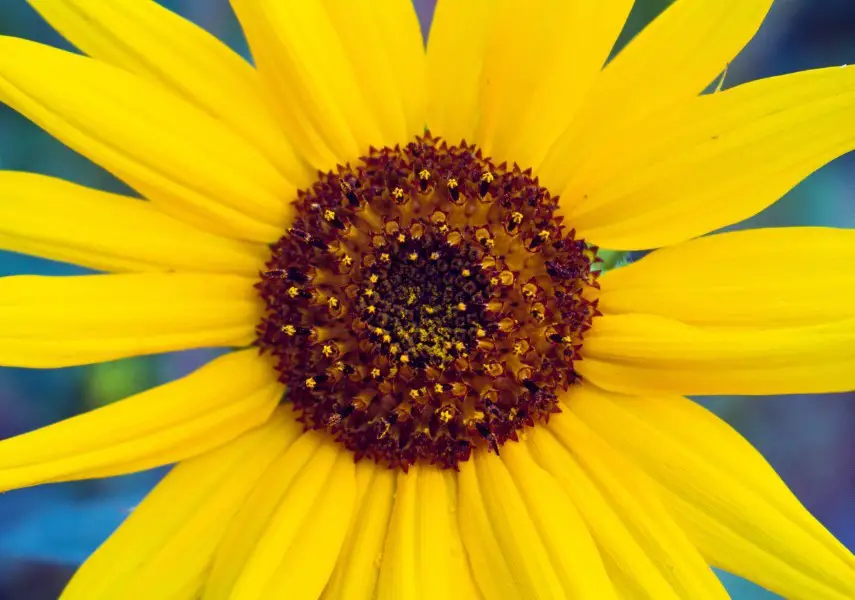
The bloom of the swamp sunflower has bright yellow petals
The swamp sunflower is easily spotted as it can grow up to 5 to 7 feet tall (1.5 to 2.5m). They can spread approximately 3 to 5 feet wide (1 to 1.5m).
The multiple thin, dark purple stems produce dark green narrow leaves. Each plant can produce between 3 – 16 flower heads.
For most of the growing season, the swamp sunflower grows quite straggly, and when it does come into bloom, there may be a chance the plant will fall over with the weight of the abundant flowers bursting out at the top of its stems.
They bloom and explode their gorgeous golden yellow colored flowers in the late summer and early autumn.
The Swamp sunflower attracts many pollinators such as butterflies, bees, songbirds, and small mammals. The deadheads give a seed feast for wildlife in the autumn and winter months.
Where the Swamp Sunflower Grows in the Wild
The Swamp sunflower is typically found in coastal plain habitats. The coastal states from Texas, Long Island to Missouri have abundant swamp sunflowers. They grow wild across many Eastern, South and Midwest states in the US and in coastal marshlands. And are native to Florida.
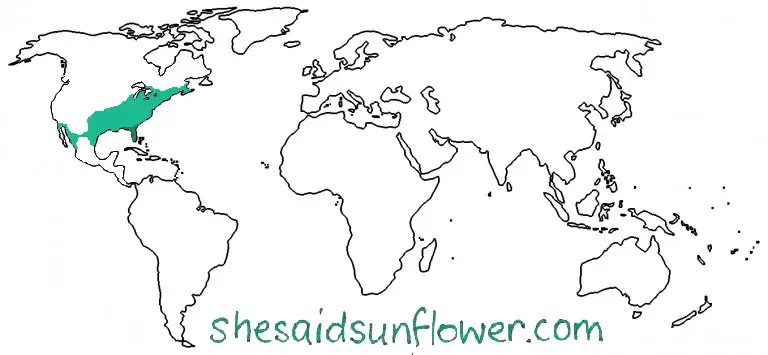
The above map shows an approximate geographical spread of the swamp sunflower – enjoying its natural habitat
Where to Place the Swamp Sunflower and Its Uses
As the name suggests, the swamp sunflower grows in wet areas. They prefer to grow in moist, soggy, clay-based or poorly drained soil. Sites that are waterlogged for longer periods are also an ideal place for swamp sunflower to grow in.
Despite its name, you don’t need a swamp to grow the swamp sunflower in – but it helps!
But seriously, the good news is they can grow in normal garden soil, but may need more water during the summer. Swamp sunflowers are salt tolerant too, so are ideal for coastal gardens and yards. They can grow in dappled shade, but may not produce as many flowers.
Because the Swamp sunflower grows so vigorously tall and wide, I’d suggest placing it at the back of borders. Or if you have a wildlife area, spread the seeds and let it grow to its heart’s content.
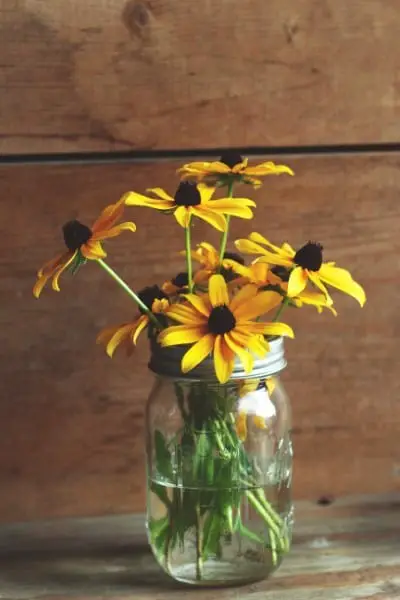
You can cut Swamp Sunflower blooms to display in vases. Cut them just as they’re opening, this will encourage the plant to produce more buds and blooms to enjoy.
Another use for Swamp Sunflowers, and with most sunflowers varieties, is they’ll clean and cleanse toxins out of the soil. Leaving a better quality of soil for you to start growing again.
Pick Your Swamp Sunflower Seeds
If I’ve enticed you into liking the idea of growing Swamp sunflowers, and you can’t find the seeds locally, I’ve found them for you on amazon.
Swamp Sunflower Seeds
Knowing we can get the seeds for sowing, let’s get growing
Basic Gardening Terms
I’ll start off with some basic terms, and what they mean for the Swamp Sunflower.
- Annual. The Swamp Sunflower is categorized as an Annual. This means it will grow, live and produce seeds one year.
- Potting On. To divide seedlings or plants that have outgrown their pots, into their own pots so they have further room to grow and mature.
- Thinning out. If a number of seedlings are growing in the same growing site, and are growing too close together, remove the other plants and space them out accordingly, to give more room to grow.
- Hardening Off. Two weeks before the danger of frost has gone, gradually accustom seedlings that have been grown indoors to the outside world. Do this by placing them out each day for several hours, then bring them in at night. For the second week increase the hours out, until they are out all night and ready to be planted out.
- Planting Out. Planting seedlings or plants in their growing sites. Tender sunflower seedlings need to be hardened off before planting out when all danger of frost has passed.
- Dead Heading. The Swamp sunflower grows multiple heads throughout the summer season. Removing the deadheads encourages new buds and flowers to grow.
- Companion Planting. Sunflowers can be planted alongside other flowers, herbs, and vegetables. This helps to attract pollinators and good bugs to help prevent infestations and diseases. I’ve written an article about the best companion plants, and what not to plant next to sunflowers. I hope you find it helpful.
How to Grow Swamp Sunflowers
Most sunflowers are easy to grow, and the Swamp sunflower is no exception, it’s easy to grow too.
When to Plant Swamp Sunflower Seeds
If you’ve bought a packet of seeds, with a few instructions on the back, or been gifted seeds from a friend, here are answers to questions about how and when to plant them. And the aftercare they need.
There are 2 ways you can start seeds off. The first is to sow them in pots inside during the middle of spring.
The second is when all fear of frost has gone. Sow straight outside into their well prepared, sunny growing site.
So, let’s start with growing them indoors. Here’s what to do…
How to Grow Swamp Sunflowers Seeds in Pots Inside
In the middle of spring, about 4 weeks before the last frost has gone, fill small clean pots with clean compost, or soil and water them. Place 3 seeds on the surface of the moistened soil and gently push them into the soil so they are just covered up.
Place the pots on a sunny window sill, or in a greenhouse and keep the soil damp. When the seedlings have grown their second true leaves, ease the plants out of their pots and gently separate each plant at its roots.
Replant into separate pots, with more soil. Place them back in their sunny place and keep them moist with water.
After hardening off your seedlings, and when all fear of frost has passed, plant on your Swamp Sunflower seedlings into a sunny, well prepared, well-drained, weed-free growing site.
If the soil you have is poor, dig in some slow-release plant food, or add a little liquid fertilizer when you water them.
Swamp Sunflowers grow quick and bushy, so distance your seedlings about 36 inches (90cm) between each plant.
This gives them room to grow, and air to circulate around each plant. This will help them fight off diseases and gives good bugs room to visit and help protect the plants for you.
Keep your Swamp Sunflowers well watered, try not to let them dry out.
As the flowers appear, cut them for display, or deadhead them when they die back. This will encourage new buds and flowers to appear.
How to Grow Swamp Sunflower Seeds Outside
Despite them being called Swamp Sunflowers, you don’t need your own swamp to grow them – but it helps!
But seriously – Swamp Sunflowers need a sunny place to grow. Prepare your growing site a few weeks, or a month before you want to start sowing your seeds.
This would be a good time to dig in any organic or leaf mulch you’ve gathered throughout the winter months.
Sunflowers can tolerate growing in bad quality soil, but if you still feel it is poor quality, then dig in some slow-release fertilizer, or use liquid plant feed once a week. Keep the site well water and damp.
When all fear of frost has passed, water the growing site and place 2 to 3 Swamp Sunflower seeds onto the surface of the soil where you want your plants to grow. Gently push the seeds into the soil, so they are just covered up.
Protect your seeds with netting or wire mesh to stop critters digging them up and feasting on them. And water them.
When your Swamp Sunflowers seedlings start to appear and have grown their second true leaves, leave the strongest in place and thin out the rest to about 36 inches (96cm) apart.
Water them in, and if you feel your local wildlife wants to munch on your juicy seedlings, protect them with netting or wire mesh.
If you have too many seedlings leftover and haven’t the heart to dispose of them, pot them up and gift them to family, friends, and neighbors.
Growing Swamp Sunflowers in a Large Area
If you are in a coastal area, have rambling fields or prairie that you’d like to grow this beautiful, wildlife-loving sunflower in, I’ve put together the following quantity of seed measurements that you might need for coverage. I hope it helps.
- 100 seeds cover an approximate of 20 sq. ft.
- 1 ounce (31,000 seeds) cover an approximate of 900 sq. ft.
- 1 pound (500,000 seeds) cover an approximate of 15,000 sq. ft.

How to Care for Your Swamp Sunflower
Swamp Sunflowers need little maintenance, especially if you’ve decided to grow them as a wildflower in a vast space. Many other sunflowers can withstand drying out so try and keep them well watered.
When you’ve first planted your sunflowers out, water them gently at the base of the plant, so as not to dislodge the soil around the roots. And keep them well watered.
Keep the area ‘weed free. Weeds grow fast and suck all the water and nutrients away from your swamp sunflower. If weeds become a big problem, use a mulch to keep moisture in and weeds at bay.
Watch out for pests and problems. Gather up pesky creatures as soon as you see them. Such as cutworms, snails, slugs, and caterpillars, and put them in another area.
Cut away any diseased or grub infested leaves and discard them. This will stop the problem from spreading to other plants.
Harvesting Swamp Sunflower Seeds
If you are leaving the seeds that your swamp sunflower produces to the local wildlife, they will be very thankful to you.
But if your intentions are to grow some for the following year, take note of when the critters are munching on them and grab some for yourself. And this is how.
Because the swamp sunflower produces a multitude of blooms and attracts an abundance of pollinators, they also create a whole lot of seeds.
These seeds come after the flower has died back. They are dark brown, grey or black in color and ovoid shaped.
How to Harvest Swamp Sunflower seeds
- Carefully cut the dried and dying flower heads from the plant
- Hold the seed-filled flower head over a tray, or container to catch the falling seeds
- Gently brush and pull your fingers over the seeds
- Pluck and wiggle any stubborn seeds out
Collect the amount you need to plant the following year. You can collect enough to gift for family and friends too.
The rest can be left for the birds and wildlife to happily munch on at their leisure.
How to Store Swamp Sunflower Seeds
- Remove any debris from the seeds such as plant matter, dried leaves, petals, and stalk.
- Clean the seeds from any pollutants and small beasties
- Air dry thoroughly.
- Store the seeds in sealed paper bags, envelopes, sealed plastic bags or containers, or in a sealed tin.
- Remember to write the name and date of your seeds on what you’re storing them in.
- Store them in a dry place, away from the clutches of wildlife.
Enjoy the fruits of your labor when you plant and grow them next year.
Take Away Swamp Sunflower Planting Guide and Chart
Depending on your climate and your growing conditions, the growth of your swamp sunflowers my vary.
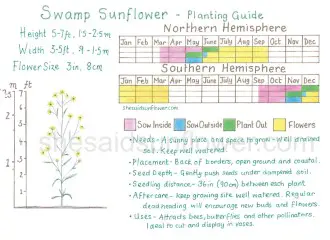
Swamp Sunflower take away planting guide and chart can be downloaded here
This is a summarized chart of how to sow, grow, and care for Swamp sunflowers. Please note, this watermarked version is free to download. it is for your own personal use to print, pin or post. it is not for ….commercial gain or usage.
Pick Your Swamp Sunflower Seeds
Swamp sunflowers attract bees, butterflies, birds and a multitude of other wildlife. they are beautiful cut and displayed in vases too.
If you’d like the seeds for yourself, or as a gift for a sunflower lover, I’ve added the link below, along with an unwatermaked planting guide link…
Swamp Sunflower Seeds
Why Not Add My Swamp Sunflower Guide
Without The Watermark
My Other Helpful Sunflower Guides and Articles
I’ve written many articles that will help you choose, sow and grow the most gorgeous sunflowers. There are quick and easy to use take away diagrams, guides, and charts for you to download, pin, post or print out. Here are the articles, I hope you find them helpful.
31 Most Wonderful Sunflowers. With Height Guide. Tried and Tested
How to Grow Amazing Sunflowers
Do Sunflowers Need a Lot of Water
Why are Sunflowers Drooping, Falling Over or Wilting
Best Sunflower Companion Plants, Vegetables and Flowers
My Conclusion
The swamp sunflowers may bush out and take up more space than a single stemmed, single-headed iconic sunflower, but, they are wild and magnificent all at the same time. And ideal for wide open spaces and wet boggy lands.
They attract butterflies and bees and look stunning as cut flowers arranged in vases. Grow them at the back of your borders or in an area that you’ve donated for the wildlife or a large area that you want to look happy and cheerful.
The Swamp Sunflower brings blooming joy throughout the summer. And if I’ve given you good reason to grow some, I’m sure they’ll fill your summer with brightness too.

